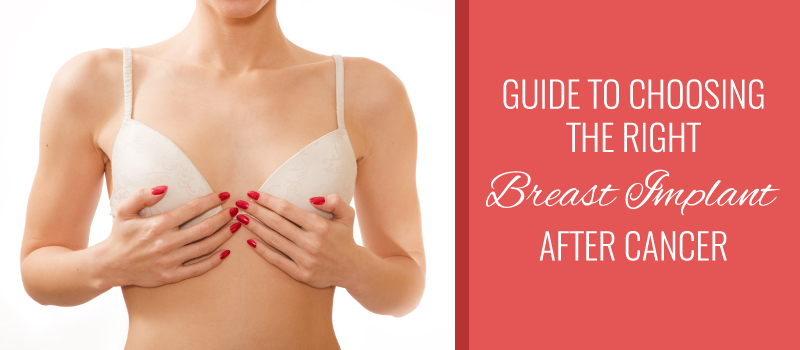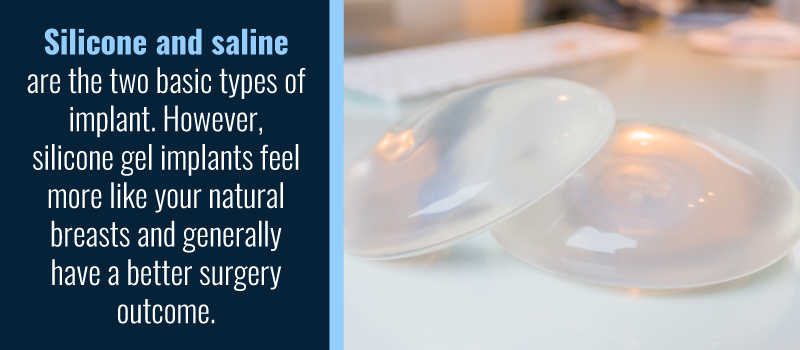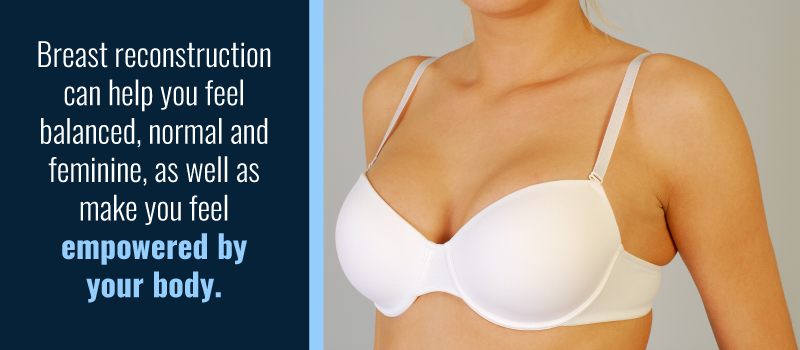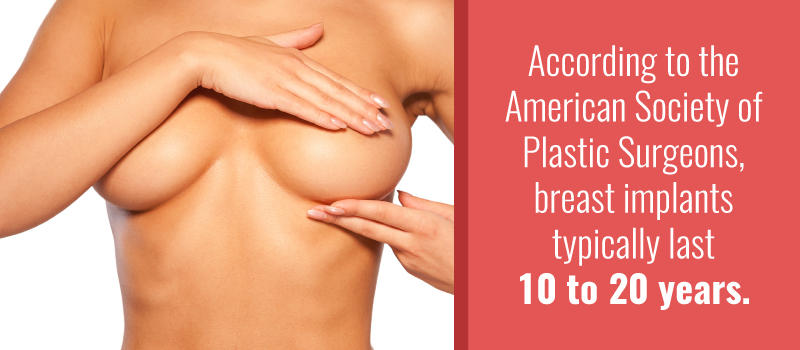Guide to Choosing the Right Breast Implant After Cancer

If you’ve had to have one or both breasts removed due to cancer, breast reconstruction can help restore your confidence and leave you looking and feeling your best. One of the best breast reconstruction surgeons in Nashville, TN is osteopathic physician Dr. Brought of SPRSI who is a FACOS Board-Certified Plastic Surgeon.
Breast reconstruction surgery after a mastectomy is a procedure that can include reconstruction, augmentation, lift and/or reduction of the breasts. Since every person’s goals and needs are distinct, the versatility of breast reconstruction surgery makes it a popular choice among women who have battled cancer. Still, it can be challenging to decide what types of breast implants are best for your individual situation.
It’s important to consult with your plastic surgeon before your breast reconstruction surgery so he can discuss the treatment and reconstruction options that are best for you.
Implant reconstruction after radiation is common in women, but it might not be ideal for you. Breast augmentation after lumpectomy are designed to rebuild your breast mound so that it matches the shape and size of your other breast. Many surgeons may also add the nipple and areola (the dark area surrounding your nipple).
The Difference Between Breast Implants, Breast Revisions and Augmentations
You have options when it comes to breast reconstruction after cancer. Therefore, it’s best to know the difference between each.
Breast Implants
As mentioned, an implant after breast reconstruction won’t feel or look like your other natural breast. This is particularly true as you age and the shape of your natural breast changes. Because of this, implants are better if you have smaller or medium-sized breasts that don’t sag or sag very little.
Augmentations
Breast augmentation after lumpectomy and radiation surgery is where your surgeon uses fat or implants to restore volume in your breast, or to increase your breast size when you’ve lost volume after pregnancy or weight loss.
Breast Revisions
Your surgeon performs a breast revision to replace or remove a silicone or saline breast implant. The surgeon performs this procedure to change the type of implants you have, or their size. He’ll also use this surgery to correct any complications or unsatisfactory results following a breast augmentation or reconstruction you had.
How to Choose the Right Implant Size
A good thing about a mastectomy is that, if you have group health insurance, you can have your new breast match your natural breast.
When choosing the right implant, there are some things to consider.
Type of Implant
Silicone and saline are the two basic types of implant. However, silicone gel implants feel more like your natural breasts and generally have a better surgery outcome. Dr. Brought will rarely use saline implants in breast reconstruction due to the fact that several studies show an overall increase in possible complications with regards to reconstruction patients specifically who are being treated for breast cancer. Each patient is different and he will gladly discuss all of the possible options.
Size of Implant
If you choose silicone implants, you’re limited to a fixed size. With saline implants, however, your surgeon can fill them while performing the surgery so he can match them more accurately to your natural breasts.
The size of your implants depends on whether you’re looking to match your natural breast, if you wish to alter your breast size and the weight of tissue the surgeon removes during your mastectomy.
Durability
Either type of implant is fairly durable. Silicone implants today are made of gel which, if torn, is designed not to run into your body. Even though you may need to have your breast implant replaced in your lifetime, if complications such as ruptures are identified, they should be addressed immediately.
If tissue is to be used during your reconstruction, you might wish to consult with your surgeon about using your own.
Choosing the Right Implant Shape
Now that you know how to choose the right breast implant for your personal situation, it’s time to choose the right shape. Implants come in a variety of sizes, types and shapes.
Gummy Bear
Gummy bear implants (form-stable implants) keep their shape even if the shell of the implant breaks. The gel inside is thicker than silicone found in other implants, which makes them firmer and less likely to break than traditional implants. These implants are not so much round, but rather taper towards the top and project at the bottom to maintain a more natural shape.
Keep in mind that it takes a mildly longer skin incision to place gummy bear implants. Since they’re shaped, there’s more of a chance of an uneven appearance if they rotate.
Saline Breast Implants
Saline implants have a substance inside that’s like salt water, held within an exterior silicone shell. The surgeon usually fills them after he places them to help form symmetry. The incision needed is smaller, since the doctor inserts them prior to filling them.
Saline breast implants are used for breast augmentation patients 18 years of older, and for breast reconstruction patients of any age.
Silicone Breast Implants
These implants also have a silicone shell, but there’s a thick synthetic gel inside that gives them a more natural texture and appearance. They’re less vulnerable to rippling, which is why they’re a good option if you have a thinner body.
Silicone breast implants are FDA-approved for breast reconstruction patients of any age and for breast augmentation for women 22 years old or older.
Round Breast Implants
These implants usually provide more projection than shaped implants do. Rotation is of no consequence since they’re round and the same shape all over.
Smooth Breast Implants
These implants may offer more natural movement, since they often move with your breast implant pocket. These implants, however, could have some visible rippling.
Textured Breast Implants
These implants don’t move around or get repositioned as much inside your breast, because they develop scar tissue, which sticks to your implant. Texturing may diminish the risk of forming a tight scar capsule.
Tips for Choosing the Right Plastic Surgeon
Choosing the right kind of breast implants after lumpectomy or mastectomy might be your biggest concern. However, you should also be very picky when it comes to choosing the right plastic surgeon to perform the surgery.
Things to look for include:
Qualifications
You should only choose a board-certified plastic surgeon to perform your breast reconstruction surgery.
Experience
Look into your surgeon’s experience and history to see if he or she has performed other procedures like this is. He should also be experienced in handling breast cancer patients and the variety of options available to them, such as using your own tissue for recreating the breast. Be sure to look for proof of a surgeon’s work, typically found on their website.
Skin-Sparing Options
Consult with your surgeon to see if your treatment allows the skin of your breast to be saved. Your surgeon can use this approach to create a pocket of skin, where he’ll place your implant. If you have a large tumor, you might be able to shrink it with chemotherapy first and then go for the skin-sparing procedure.
Nipple-Sparing Options
Your doctor might be able to save your nipple, depending on where your tumor is located and its size.
Facility
See if you can tour the practice or clinic to see where your procedure will take place. It helps to be familiar with the facility, since you’ll be returning in the future for follow-up appointments.
Benefits of Breast Reconstruction Surgery
Breast reconstruction can help you feel balanced, normal and feminine, as well as make you feel empowered by your body. You’ll also feel better about wearing certain types of clothing with comfort and confidence.
There are many reasons why you might choose breast reconstruction:
- To regain your breast shape permanently
- To balance out the look of your breasts when you wear a swimsuit or bra
- To not need to wear an external prosthesis inside your bra
- To renew your confidence from implant reconstruction after radiation
According to clinical studies, Breast reconstruction doesn’t cause your breast cancer to come back. If your cancer does come back, your reconstructed breasts shouldn’t affect your radiation or chemotherapy treatment. Also, breast reconstruction after lumpectomy radiation is typically not a problem for most women.
Although this surgery might leave scars which may be visible when you’re naked, over time they should fade. Scarring can be reduced through a number of newer techniques. Topical solutions can aid in reducing or eliminating the appearance of your scar while other gels and creams are also available on an over-the-counter or prescription basis. Some plastic surgeons offer scar treatments which can include but are not limited to surgical removal, cryotherapy, steroid injections and silicone sheets.
Remember — your reconstructed breasts won’t match your natural breasts exactly. If your surgeon used tissue from your buttocks, tummy or back in your reconstruction, after surgery those areas may also look slightly different. You should discuss changes in contour or shape and surgical scars with your surgeon, as well as how the surgical area will feel and look after it’s healed.
Things You Should Consider Before Your Breast Reconstruction
Prior to undergoing breast reconstruction and implant therapy, there are some things you should take into consideration, including your reasons for getting the surgery and your expectations.
The FDA recommends you consider the following factors before undergoing your reconstruction, revision or augmentation surgery:
- You increase your risk of experiencing adverse outcomes and local complications the longer you have breast implants.
- You need to monitor your breast implants indefinitely for any complications or abnormal changes. If you notice any changes, visit your doctor right away.
- You may be advised to get periodic MRI exams if you’ve received breast implants that are silicone- and gel-filled. This is to detect any silent ruptures (i.e. ruptures that don’t cause symptoms).
You also need to know about common potential adverse outcomes and complications, which include:
- Implant removal
- Capsular contracture
- Implant deflation or rupture
- Reoperation
- Asymmetry
- Pain
- Wrinkling
- Scarring
- Implant extrusion
- Infection
Sitting down and going over all considerations with your plastic surgeon is important. You don’t want to jump into the procedure blind and be disappointed or, worse, have complications that you weren’t aware could happen. Having a consultation with a surgeon like Dr. Brought will ensure you are approaching this surgery in a comprehensive, holistic way and ensuring that you cover all possible complications and other things that you should take into consideration during your initial pre-surgery consultation.
Recovery Time After Your Breast Reconstruction and Implant Procedure
They type of reconstructive surgery you have will be the main factor for your recovery time. You should be feeling better after a couple of weeks and be able to get back to your regular activities in a couple of months. It might take a little more time for your double mastectomy reconstruction recovery. Set up a consultation with your doctor to discuss things like breast care follow-up, taking care of your surgery areas and regular mammograms.
Infection is possible following surgery, typically within the first couple of weeks. Your surgeon may have to remove your implant to allow the infection to clear and put a new implant in afterwards. He may have to clean the wound through surgery if you have a tissue flap.
Longevity of Your Breast Reconstruction and Implant Surgery
According to the American Society of Plastic Surgeons, breast implants typically last 10 to 20 years. Therefore, it is possible that you’ll need to have your implants replaced with additional surgery at some point.
Requirements for Being a Good Candidate for Breast Reconstruction
Not everyone is a good candidate for this type of surgery. Your general health, type of cancer and your preferences are factors that play a role in determining whether or not you’re a good candidate. For example, if it’s determined that the surgery will interfere with your breast cancer treatment, you might not be a good candidate.
Furthermore, if you’re a smoker or are overweight, breast reconstructive surgery could increase your risk of complications. You’ll want to talk with your Franklin, TN surgeon about potential complications such as infection, wound healing, problems with implants and reconstruction failure before committing to surgery.
Your plastic surgeon may just delay your surgery for a little while after you lose weight or quit smoking, which can lower your complication risks. He or she will likely give you advice on how to lose the weight or quit smoking, as well.
Additionally, other things that could affect your situation include:
- You already have health problems and are in poor health.
- You require radiation or chemotherapy to treat your breast cancer and need to delay your surgery until you’ve finished treatment.
- You have scarring from previous surgeries, which limits what kind of reconstruction you’re able to receive.
- You have expectations that are unrealistic. Reconstructed breasts aren’t the same as your natural breasts.
If you’ve been cleared to have both chemotherapy or radiation therapy and breast reconstruction, there are some factors to consider for management, which include:
- Timing of chemotherapy and reconstruction
- Timing of radiation and reconstruction
- The type breast implants after mastectomy and radiation.
Decisions like these are best made through a team approach, involving your plastic surgeon as well as radiation and medical oncologists.
Consult With Southern Plastic & Reconstructive Surgical Institute
The decision to have breast reconstruction can be a complicated one. Deciding if you should have breast reconstruction after mastectomy or lumpectomy is a personal choice. It’s important that you take the time you need to make a wise decision. Make sure you learn all you can about how breast reconstructive surgery may affect you, both physically and emotionally, before committing to the surgery.
Since you have a variety of choices, it can often be more challenging than selecting the type of treatment you want for your cancer. Talk with your surgeon to go over all of your options and choose the option that’s best for you. If your plastic surgeon is experienced enough, he or she can help you choose the best option for your unique situation. You’ll be presented with all of your options to review. In addition, you may choose to talk with a couple plastic surgeons to get the full knowledge you need before making your decision.
Don’t forget to keep your cancer treatment in mind when you’re making your choice, as this does need special consideration. Be sure to set your appointment up today to talk with a Nashville, TN or Franklin, TN board-certified plastic surgeon who’s both skilled and experienced in breast reconstruction and implant surgery.
If you have questions about choosing the right breast implant after cancer, contact Dr. Brought, our Franklin, TN plastic surgeon at the Southern Plastic & Reconstructive Surgical Institute (SPRSI) at 615-791-9090 or schedule an appointment.




